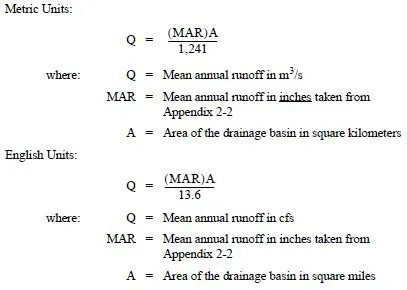The first step in performing a hydrologic analysis is to determine the most appropriate method. The methods for determining runoff rates and volumes are summarized below, and Table 2-1 provides a comparison table. Subsequent sections provide a more detailed description of each method. Additional guidance will be provided in future revisions to the Hydraulics Manual.
• Rational Method (Kuichling 1889): This method is used when peak discharges for basins up to 200 acres must be determined. This method does not provide a time series of flow or flow volume. It is a simple and accurate method, especially when the basin is primarily impervious. The Rational Method is appropriate for culvert design, pavement drainage design, and storm sewer design. It is also appropriate for some stormwater facility designs in eastern Washington.
• Santa Barbara Urban Hydrograph (SBUH) Method (Stubchaer 1975): This method is used when estimation of a runoff hydrograph is necessary. The SBUH Method also can be used when retention and detention must be evaluated. The SBUH Method can be used for drainage areas up to 1,000 acres. The SBUH Method can be used for stormwater facility designs in eastern Washington and for culvert and storm sewer designs through the entire state.
• Continuous-simulation hydrologic model: For western Washington, calibrated continuous-simulation hydrologic models, based on the Hydrological Simulation Program-Fortran (HSPF) routine, have been created for computing peak discharges and runoff volumes. These models are used for stormwater facility designs in western Washington and estimating seasonal runoff for temporary stream diversions. WSDOT uses the continuous-simulation hydrologic model MGSFlood when calculating runoff treatment rates and volumes for stormwater facility design. Programs other than MGSFlood may be used if approved by the State Hydraulics Office.
• Published flow record: This method shall be used whenever appropriate stream gage data are available. This is a collection of data rather than a predictive analysis like the other methods listed. USGS, cities, counties, and other agencies gather stream flow data on a regular basis. Collected data can be analyzed statistically to predict flood flows and are more accurate than simulated flows. Published flow records are most appropriate for culvert and bridge design.
• USGS regional regression equations (Mastin et al. 2016): This method can be used when no appropriate stream gage data are available. It is a set of regression equations that were developed using data from stream flow gaging stations. The regression equations are simple to use but are less accurate than published flow records. USGS regression equations are appropriate for culvert and bridge design and are intended for use in rural and predominantly undeveloped basin areas. PEOs should consult the USGS regression equation documentation for limitations when computing flows in urban basins (basins with greater than 5 percent impervious area).
• Existing hydrologic studies: This method uses existing studies or models of the watershed of interest, including Federal Emergency Management Agency (FEMA) flood insurance studies, smaller urban drainages, citywide or countywide drainage master plans, and calibrated HSPF models. Often these values are accurate because they were developed from an in-depth analysis. Flood report data can be derived from FEMA and other approved sources, including the State Hydraulics Office. Obtained data may be appropriate for culvert and bridge design.
• Basin transfer of gage data with regional USGS equations: When a project is located on an ungaged stream, but a stream is nearby with a substantial flow record, it is possible to extrapolate flows from one basin to the other, provided that certain criteria are met. The watersheds of the gaged and ungaged streams must have similar geology and soils, elevation range, vegetation, and canopy cover, and must be roughly the same size. The concept is simple (see Equation 2-1):

USGS offers a spreadsheet called Flood Q Tools that includes the Flood Q Ratio Tool, which incorporates weighting of the ratio-based discharge. The weighting function uses the appropriate regional regression equation. Flood Q Tools can be found at the following link: FloodQtools.xlsm (live.com).
The Flood Q Ratio Tool puts bounds on the ungaged site—it must be within 50 percent of the area of the gaged basin and on the same stream. However, if no other tools are available, it may be used to estimate flows on a different stream, provided that all other parameters (basin size, soils, elevation, etc.) are similar. This tool also has the functionality of using the regression-based weighting of the Q derived from the area ratio. Additional inputs for this technique are mean annual precipitation and percent canopy cover (for Regions 1 and 2) in the ungaged basin.

